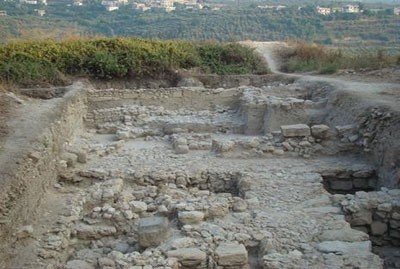LATTAKIA, (ST) – Tel Siano is one of the five largest archaeological hills on the Syrian coast and is located to the east of the city of Jableh. It is 10 hectares and in area and rises 148 meters above sea level. It is 40-meters above the plain it surrounds and at its peak there is a triangular spatial point that can be seen from all sides.
Director of Lattakia Antiquities, Dr. Jamal Haider, said that the hill is made up of brown clay that lamellas of dust accumulated above it of different heights. Up the hill there is a clump of trees that shade a few graves and trees distributed on the roof of the hill including oak, pine, hawthorn and other species.
Large areas on the shape of vast progressive cliffs formed in the hill, while in the western part of Siano Village there is famous well known as Siano well, pointing out that the Danish archaeological mission conducted a survey for the archaeological hills in the southern region of the province and unearthed Tel Siano.
In 1990 was the formation of A Syrian archaeological mission was formed in 1990 to rummage in the hill. Excavation resulted in archaeological levels most important is the first level which forms the surface of the hill. It does not contain any archaeological sites and consists of materials dating back to the last century and the second level backs to the seventh century AD,” Dr. Haider added.
The third and fourth levels date back to the sixth and fifth BC and the fifth level dates back to the eighth century BC. It is characterized by a big castle big that consists of three sections with a defense tower, an entrance and wide walls. The sixth level backs to the ninth century BC.
In return normalcy The seventh level backs to the / Ancient Bronze III / to the end of the third millennium BC, according to Dr. Haider, where a residential neighborhood was discovered. It consists of two groups of rooms separated by a north and south alleyway while the western group consists of 4 rooms and the eastern group consists of two rooms.
The name of Tel Siano was mentioned in the Amarna letters since the fourth century BC, in the Ugaritic and Hittite texts during the fourth and third centuries BC and in the annals of the modern Assyrian kingdom in the tenth century BC until the seventh, as well as in the book of the Torah.
“The information revealed by the pottery figures indicate the relationship of Siano by the Kingdom of Ugarit, including a message written in Ugaritic from the king of Siano to the King of Ugarit. The letter says: “Peace be upon you. May the Lord of Lords keep you, I have sent you my messenger, Aukhor, to tackle some of the issues that belong me. My brother, take care of him until the day returns. I also sent you my son, Nimo, they will have an audience with you, judge between them and let be a fair settlement with Palo man and men from Beirut who claimed that they are seeking to get some drinks from Ugarit committed hostile acts in Siano.” Dr. Haider pointed out.
This letter demonstrates the depth of relations and links that linked between the two kings even in resolving the issues that are contrary to the laws to the care of the interests of both parties.
Sh. Kh.

